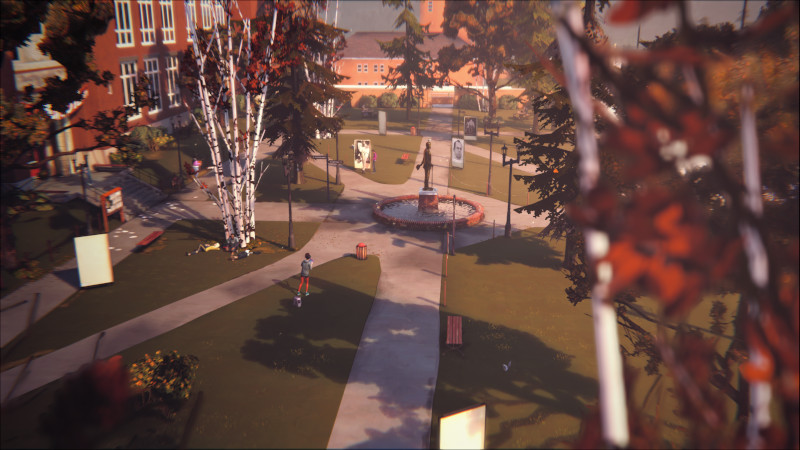Life is Strange
After playing Gone Home, I wondered if I would ever find another videogame that could affect me so deeply. I’m happy to say that I found not one, but two: namely Life is Strange and its prequel Life is Strange: Before the Storm.
Like Gone Home, these games have a strong narrative element and can be classified as coming-of-age stories. They have female protagonists and take place in Oregon.
Coincidence? Is the Universe trying to tell me something? Should I go to Oregon to meet with my destiny?
No, Merry Hermit, I hear you say. You are just a sentimental old fool who never misses a chance to melt in a puddle of tears. You may have a point.
The game revolves around eighteen-year-old Max Caulfield (full name Maxine) who returns from Seattle to Arcadia Bay, her birthplace on the Oregon coast, after five years.

She is passionate about photography and has enrolled at Blackwell Academy, the local high school, where renowned photographer Mark Jefferson teaches the subject.

Two fairly unsettling things happen to Max.
Unsettling thing number one: she has visions of a devastating tornado going to hit Arcadia Bay.

Unsettling thing number two: she discovers she can rewind time. Yep, that’s right. She can do something, see how it plays out and then go back a few minutes to do something different. I can think of about a thousand occasions in which this power would have helped me a lot, and I’m sure you can too.
I won’t disclose how Max finds out about her power. But as if this wasn’t complicated enough, her childhood friend Chloe Price reappears all of a sudden. Max hasn’t seen Chloe since leaving Arcadia Bay to move to Seattle with her family. Chloe had just lost her father in a car accident, and Max had not been there for her, nor could she find the courage to contact her afterwards. This is a constant source of shame and regret for Max.
Chloe now drives a battered old truck, has blue hair and is incredibly badass. After some initial awkwardness, the two quickly rekindle their friendship. After Max tells Chloe about her powers, they decide to use them to look for Rachel Amber. Rachel became Chloe’s best friend after Max left, but now she’s gone missing. What happened to her, and who’s behind her disappearance?

I have just scratched the surface here. There’s a whole cast of secondary characters I haven’t even mentioned. The game goes from light-hearted high school antics to tragedy, and touches on difficult themes such as bullying, suicide and addiction.
Unlike in Gone Home, there are more game-like tasks, such as things to do and objects to find to move the story forward. But what sets Life is Strange apart is the movie-like experience. Every time Max examines an object or talks to another character, there’s a little cut scene where the camera pans and focuses on different details. In several places Max can just sit somewhere and reflect on her current predicament, while again the camera pans from different angles. You can let her sit for as long as you want, while admiring the scenery and listening to the lovely soundtrack.

It is worth mentioning Hannah Telle as Max and Ashly Burch as Chloe, the leading voice actors of a great cast.
Graphically, the game can’t compare with the latest blockbusters, where every blackhead and hair follicle is fully modelled in 3D. Character animation sometimes looks wooden and unnatural. On the plus side, you don’t need a power-hungry monster GPU to run the game smoothly. And anyway, these are minor flaws. Every location in the game is a pleasure to explore, and I recommend you take the time to look at every detail. Also, Max’s handwritten diary, and the photos she takes with her vintage Polaroid, document every step of her journey. They are exquisitely made.

While Gone Home is a linear story with a set conclusion, Life is Strange emphasises the importance of choices, which can lead to dramatically different outcomes. It is not as simple as there being a right and a wrong choice. As in real life, all your options can be morally dubious, all can have unintended consequences and cause regrets. I suggest making full use of Max’s rewind powers to choose different paths and see what the immediate effects are.
As you progress with the story, the atmosphere gets more and more somber, due to ominous signs bordering on the supernatural.
I can’t tell much more without spoilers. We experience the story from Max’s point of view, but Chloe is the character that leaves the strongest impression. Through her we experience gut-wrenching loss: the death of her beloved father, her best friend Max bailing on her when she was most needed, her new best friend Rachel disappearing without a trace. We see a young woman who’s been wounded by life one too many times, but still goes on fighting.
Hats off to French game studio Dontnod Entertainment for crafting a wonderful story, and for not budging when publishers told them a game with female protagonists would not sell. Hats off also to Square Enix for believing in the project and publishing the game.
Enough fanboying for now. More overexcited gushing now available in my spoiler-free review of the prequel Life is Strange: Before the Storm.
Image credits: All images are screenshots taken from my copy of the game. Copyright of all game assets is owned by Dontnod Entertainment and/or Square Enix. Low resolution versions reproduced for commentary and criticism purposes, believed to qualify as fair use/fair dealing.